A Critical Literature Review of Innovation and Change in Business
VerifiedAdded on 2023/06/10
|16
|4527
|351
Literature Review
AI Summary
This literature review explores the interconnected concepts of innovation and change within a business context, particularly concerning emerging technologies. It delves into the definitions of innovation, differentiating it from invention, and examines the roles of creativity and strategy in driving innovation. The review also covers open innovation, technological innovation, and the implications of change, including the importance of adapting processes and services. It addresses the impact of technological changes like AI and machine learning, exploring the contrasting concepts of technophobia and technophilia. Furthermore, it analyzes reactions to technological change, introducing models like Force Field Analysis and the Technology Acceptance Model, and discusses strategies for successfully managing technological change. The review synthesizes various perspectives on these critical topics, providing a comprehensive understanding of the dynamics of innovation and change in the modern business environment.
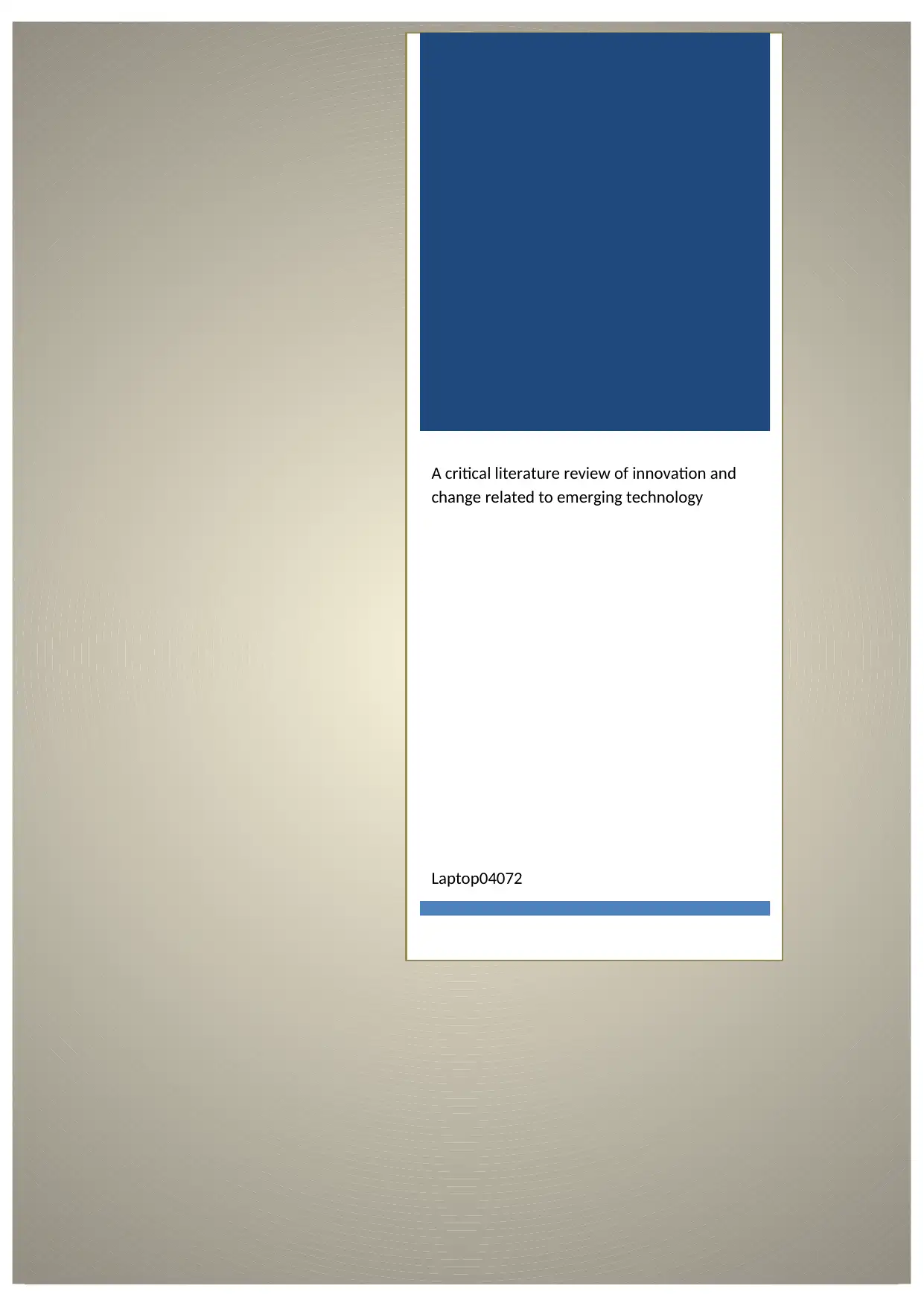
A critical literature review of innovation and
change related to emerging technology
Laptop04072
change related to emerging technology
Laptop04072
Paraphrase This Document
Need a fresh take? Get an instant paraphrase of this document with our AI Paraphraser
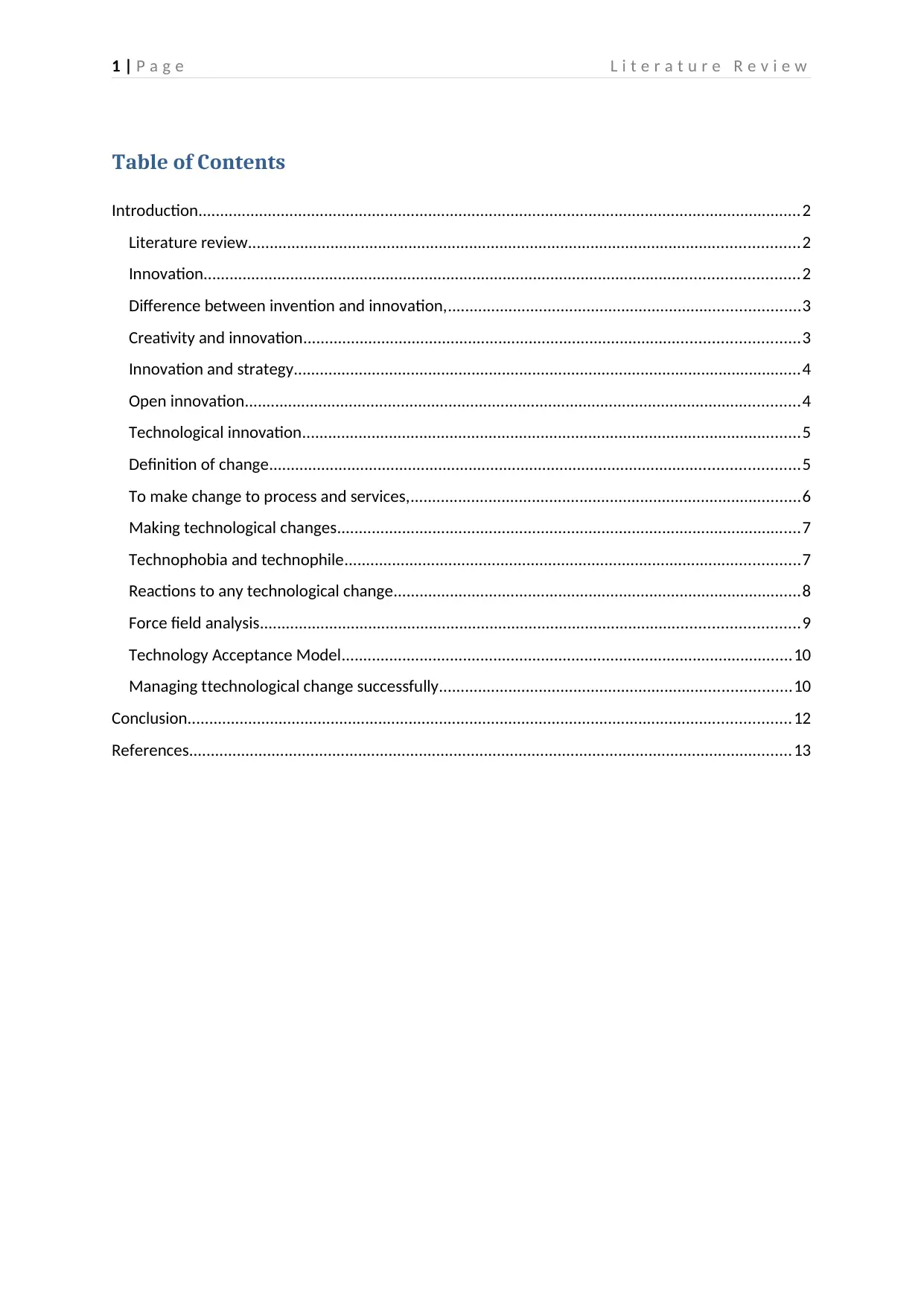
1 | P a g e L i t e r a t u r e R e v i e w
Table of Contents
Introduction...........................................................................................................................................2
Literature review...............................................................................................................................2
Innovation.........................................................................................................................................2
Difference between invention and innovation,.................................................................................3
Creativity and innovation..................................................................................................................3
Innovation and strategy.....................................................................................................................4
Open innovation................................................................................................................................4
Technological innovation...................................................................................................................5
Definition of change..........................................................................................................................5
To make change to process and services,..........................................................................................6
Making technological changes...........................................................................................................7
Technophobia and technophile.........................................................................................................7
Reactions to any technological change..............................................................................................8
Force field analysis............................................................................................................................9
Technology Acceptance Model........................................................................................................10
Managing ttechnological change successfully.................................................................................10
Conclusion...........................................................................................................................................12
References...........................................................................................................................................13
Table of Contents
Introduction...........................................................................................................................................2
Literature review...............................................................................................................................2
Innovation.........................................................................................................................................2
Difference between invention and innovation,.................................................................................3
Creativity and innovation..................................................................................................................3
Innovation and strategy.....................................................................................................................4
Open innovation................................................................................................................................4
Technological innovation...................................................................................................................5
Definition of change..........................................................................................................................5
To make change to process and services,..........................................................................................6
Making technological changes...........................................................................................................7
Technophobia and technophile.........................................................................................................7
Reactions to any technological change..............................................................................................8
Force field analysis............................................................................................................................9
Technology Acceptance Model........................................................................................................10
Managing ttechnological change successfully.................................................................................10
Conclusion...........................................................................................................................................12
References...........................................................................................................................................13
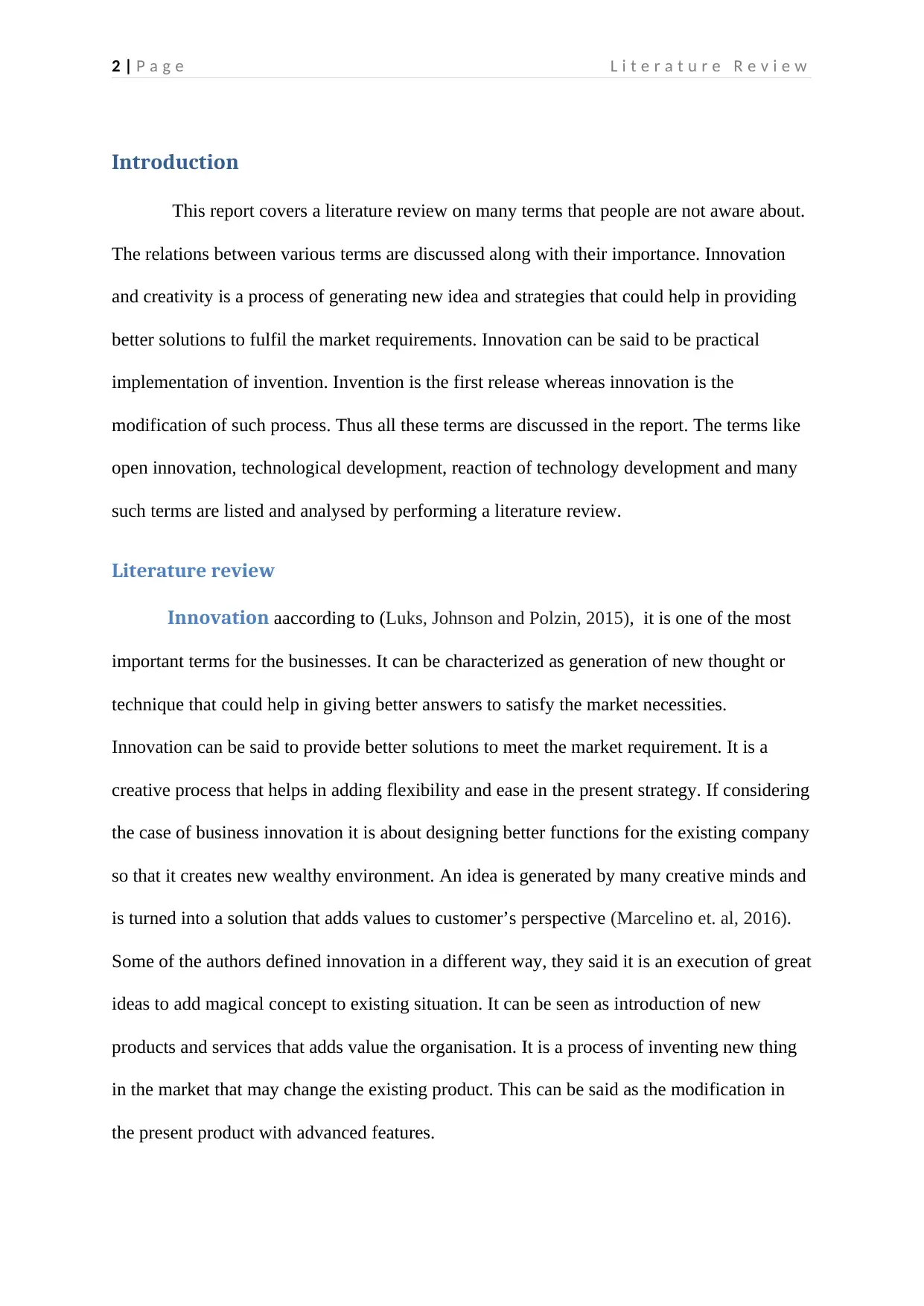
2 | P a g e L i t e r a t u r e R e v i e w
Introduction
This report covers a literature review on many terms that people are not aware about.
The relations between various terms are discussed along with their importance. Innovation
and creativity is a process of generating new idea and strategies that could help in providing
better solutions to fulfil the market requirements. Innovation can be said to be practical
implementation of invention. Invention is the first release whereas innovation is the
modification of such process. Thus all these terms are discussed in the report. The terms like
open innovation, technological development, reaction of technology development and many
such terms are listed and analysed by performing a literature review.
Literature review
Innovation aaccording to (Luks, Johnson and Polzin, 2015), it is one of the most
important terms for the businesses. It can be characterized as generation of new thought or
technique that could help in giving better answers to satisfy the market necessities.
Innovation can be said to provide better solutions to meet the market requirement. It is a
creative process that helps in adding flexibility and ease in the present strategy. If considering
the case of business innovation it is about designing better functions for the existing company
so that it creates new wealthy environment. An idea is generated by many creative minds and
is turned into a solution that adds values to customer’s perspective (Marcelino et. al, 2016).
Some of the authors defined innovation in a different way, they said it is an execution of great
ideas to add magical concept to existing situation. It can be seen as introduction of new
products and services that adds value the organisation. It is a process of inventing new thing
in the market that may change the existing product. This can be said as the modification in
the present product with advanced features.
Introduction
This report covers a literature review on many terms that people are not aware about.
The relations between various terms are discussed along with their importance. Innovation
and creativity is a process of generating new idea and strategies that could help in providing
better solutions to fulfil the market requirements. Innovation can be said to be practical
implementation of invention. Invention is the first release whereas innovation is the
modification of such process. Thus all these terms are discussed in the report. The terms like
open innovation, technological development, reaction of technology development and many
such terms are listed and analysed by performing a literature review.
Literature review
Innovation aaccording to (Luks, Johnson and Polzin, 2015), it is one of the most
important terms for the businesses. It can be characterized as generation of new thought or
technique that could help in giving better answers to satisfy the market necessities.
Innovation can be said to provide better solutions to meet the market requirement. It is a
creative process that helps in adding flexibility and ease in the present strategy. If considering
the case of business innovation it is about designing better functions for the existing company
so that it creates new wealthy environment. An idea is generated by many creative minds and
is turned into a solution that adds values to customer’s perspective (Marcelino et. al, 2016).
Some of the authors defined innovation in a different way, they said it is an execution of great
ideas to add magical concept to existing situation. It can be seen as introduction of new
products and services that adds value the organisation. It is a process of inventing new thing
in the market that may change the existing product. This can be said as the modification in
the present product with advanced features.
⊘ This is a preview!⊘
Do you want full access?
Subscribe today to unlock all pages.

Trusted by 1+ million students worldwide
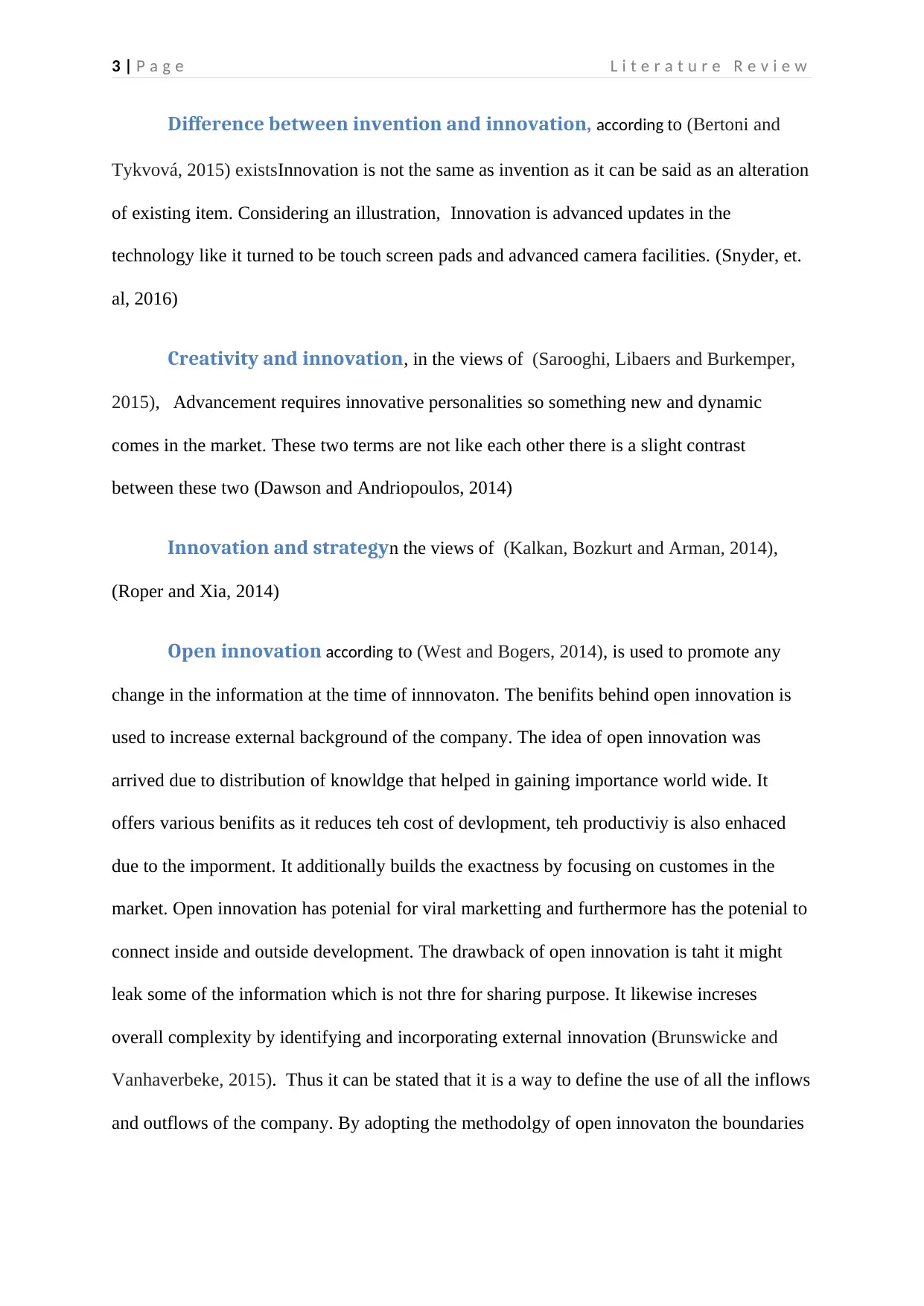
3 | P a g e L i t e r a t u r e R e v i e w
Difference between invention and innovation, according to (Bertoni and
Tykvová, 2015) existsInnovation is not the same as invention as it can be said as an alteration
of existing item. Considering an illustration, Innovation is advanced updates in the
technology like it turned to be touch screen pads and advanced camera facilities. (Snyder, et.
al, 2016)
Creativity and innovation, in the views of (Sarooghi, Libaers and Burkemper,
2015), Advancement requires innovative personalities so something new and dynamic
comes in the market. These two terms are not like each other there is a slight contrast
between these two (Dawson and Andriopoulos, 2014)
Innovation and strategyn the views of (Kalkan, Bozkurt and Arman, 2014),
(Roper and Xia, 2014)
Open innovation according to (West and Bogers, 2014), is used to promote any
change in the information at the time of innnovaton. The benifits behind open innovation is
used to increase external background of the company. The idea of open innovation was
arrived due to distribution of knowldge that helped in gaining importance world wide. It
offers various benifits as it reduces teh cost of devlopment, teh productiviy is also enhaced
due to the imporment. It additionally builds the exactness by focusing on customes in the
market. Open innovation has potenial for viral marketting and furthermore has the potenial to
connect inside and outside development. The drawback of open innovation is taht it might
leak some of the information which is not thre for sharing purpose. It likewise increses
overall complexity by identifying and incorporating external innovation (Brunswicke and
Vanhaverbeke, 2015). Thus it can be stated that it is a way to define the use of all the inflows
and outflows of the company. By adopting the methodolgy of open innovaton the boundaries
Difference between invention and innovation, according to (Bertoni and
Tykvová, 2015) existsInnovation is not the same as invention as it can be said as an alteration
of existing item. Considering an illustration, Innovation is advanced updates in the
technology like it turned to be touch screen pads and advanced camera facilities. (Snyder, et.
al, 2016)
Creativity and innovation, in the views of (Sarooghi, Libaers and Burkemper,
2015), Advancement requires innovative personalities so something new and dynamic
comes in the market. These two terms are not like each other there is a slight contrast
between these two (Dawson and Andriopoulos, 2014)
Innovation and strategyn the views of (Kalkan, Bozkurt and Arman, 2014),
(Roper and Xia, 2014)
Open innovation according to (West and Bogers, 2014), is used to promote any
change in the information at the time of innnovaton. The benifits behind open innovation is
used to increase external background of the company. The idea of open innovation was
arrived due to distribution of knowldge that helped in gaining importance world wide. It
offers various benifits as it reduces teh cost of devlopment, teh productiviy is also enhaced
due to the imporment. It additionally builds the exactness by focusing on customes in the
market. Open innovation has potenial for viral marketting and furthermore has the potenial to
connect inside and outside development. The drawback of open innovation is taht it might
leak some of the information which is not thre for sharing purpose. It likewise increses
overall complexity by identifying and incorporating external innovation (Brunswicke and
Vanhaverbeke, 2015). Thus it can be stated that it is a way to define the use of all the inflows
and outflows of the company. By adopting the methodolgy of open innovaton the boundaries
Paraphrase This Document
Need a fresh take? Get an instant paraphrase of this document with our AI Paraphraser
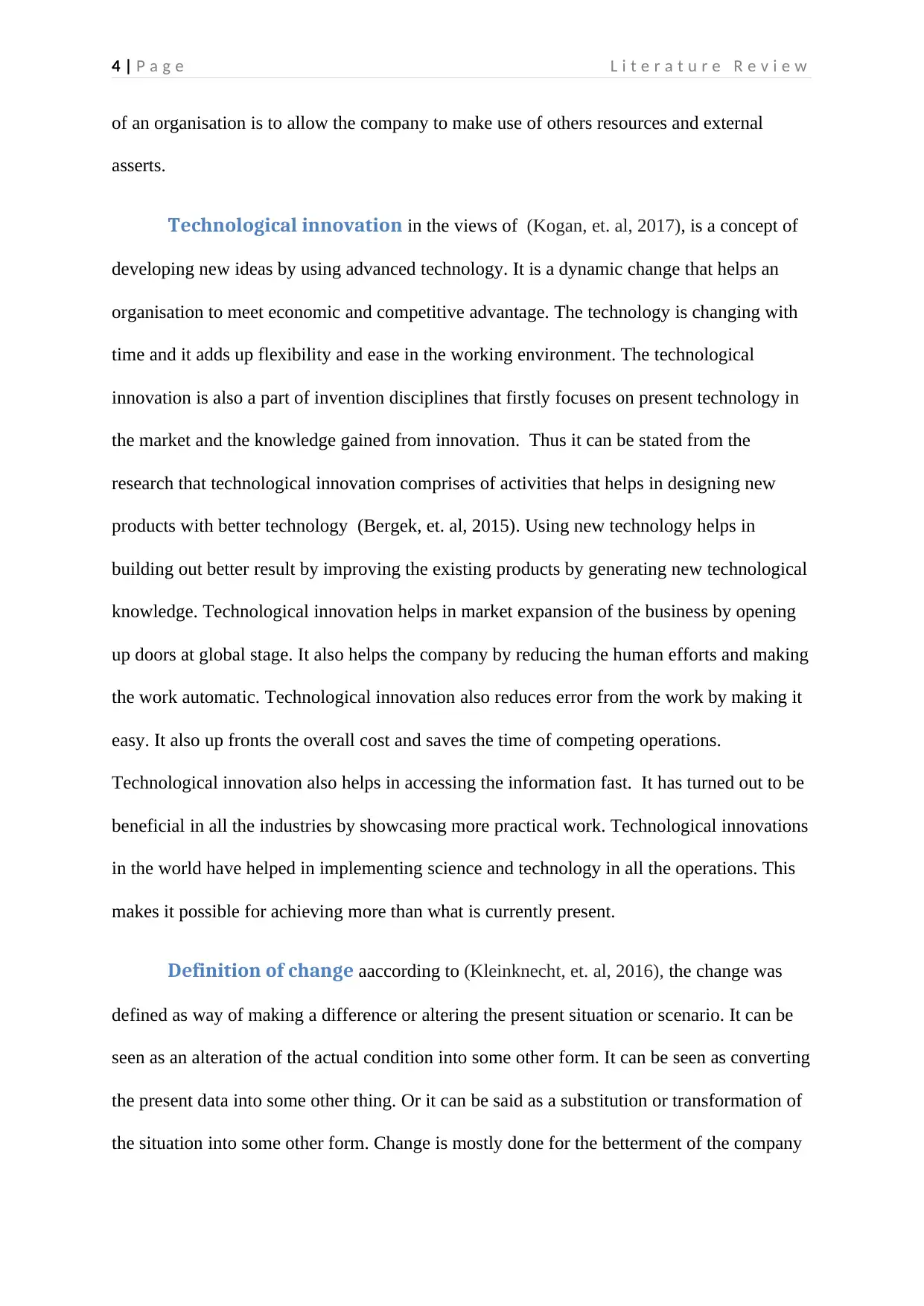
4 | P a g e L i t e r a t u r e R e v i e w
of an organisation is to allow the company to make use of others resources and external
asserts.
Technological innovation in the views of (Kogan, et. al, 2017), is a concept of
developing new ideas by using advanced technology. It is a dynamic change that helps an
organisation to meet economic and competitive advantage. The technology is changing with
time and it adds up flexibility and ease in the working environment. The technological
innovation is also a part of invention disciplines that firstly focuses on present technology in
the market and the knowledge gained from innovation. Thus it can be stated from the
research that technological innovation comprises of activities that helps in designing new
products with better technology (Bergek, et. al, 2015). Using new technology helps in
building out better result by improving the existing products by generating new technological
knowledge. Technological innovation helps in market expansion of the business by opening
up doors at global stage. It also helps the company by reducing the human efforts and making
the work automatic. Technological innovation also reduces error from the work by making it
easy. It also up fronts the overall cost and saves the time of competing operations.
Technological innovation also helps in accessing the information fast. It has turned out to be
beneficial in all the industries by showcasing more practical work. Technological innovations
in the world have helped in implementing science and technology in all the operations. This
makes it possible for achieving more than what is currently present.
Definition of change aaccording to (Kleinknecht, et. al, 2016), the change was
defined as way of making a difference or altering the present situation or scenario. It can be
seen as an alteration of the actual condition into some other form. It can be seen as converting
the present data into some other thing. Or it can be said as a substitution or transformation of
the situation into some other form. Change is mostly done for the betterment of the company
of an organisation is to allow the company to make use of others resources and external
asserts.
Technological innovation in the views of (Kogan, et. al, 2017), is a concept of
developing new ideas by using advanced technology. It is a dynamic change that helps an
organisation to meet economic and competitive advantage. The technology is changing with
time and it adds up flexibility and ease in the working environment. The technological
innovation is also a part of invention disciplines that firstly focuses on present technology in
the market and the knowledge gained from innovation. Thus it can be stated from the
research that technological innovation comprises of activities that helps in designing new
products with better technology (Bergek, et. al, 2015). Using new technology helps in
building out better result by improving the existing products by generating new technological
knowledge. Technological innovation helps in market expansion of the business by opening
up doors at global stage. It also helps the company by reducing the human efforts and making
the work automatic. Technological innovation also reduces error from the work by making it
easy. It also up fronts the overall cost and saves the time of competing operations.
Technological innovation also helps in accessing the information fast. It has turned out to be
beneficial in all the industries by showcasing more practical work. Technological innovations
in the world have helped in implementing science and technology in all the operations. This
makes it possible for achieving more than what is currently present.
Definition of change aaccording to (Kleinknecht, et. al, 2016), the change was
defined as way of making a difference or altering the present situation or scenario. It can be
seen as an alteration of the actual condition into some other form. It can be seen as converting
the present data into some other thing. Or it can be said as a substitution or transformation of
the situation into some other form. Change is mostly done for the betterment of the company
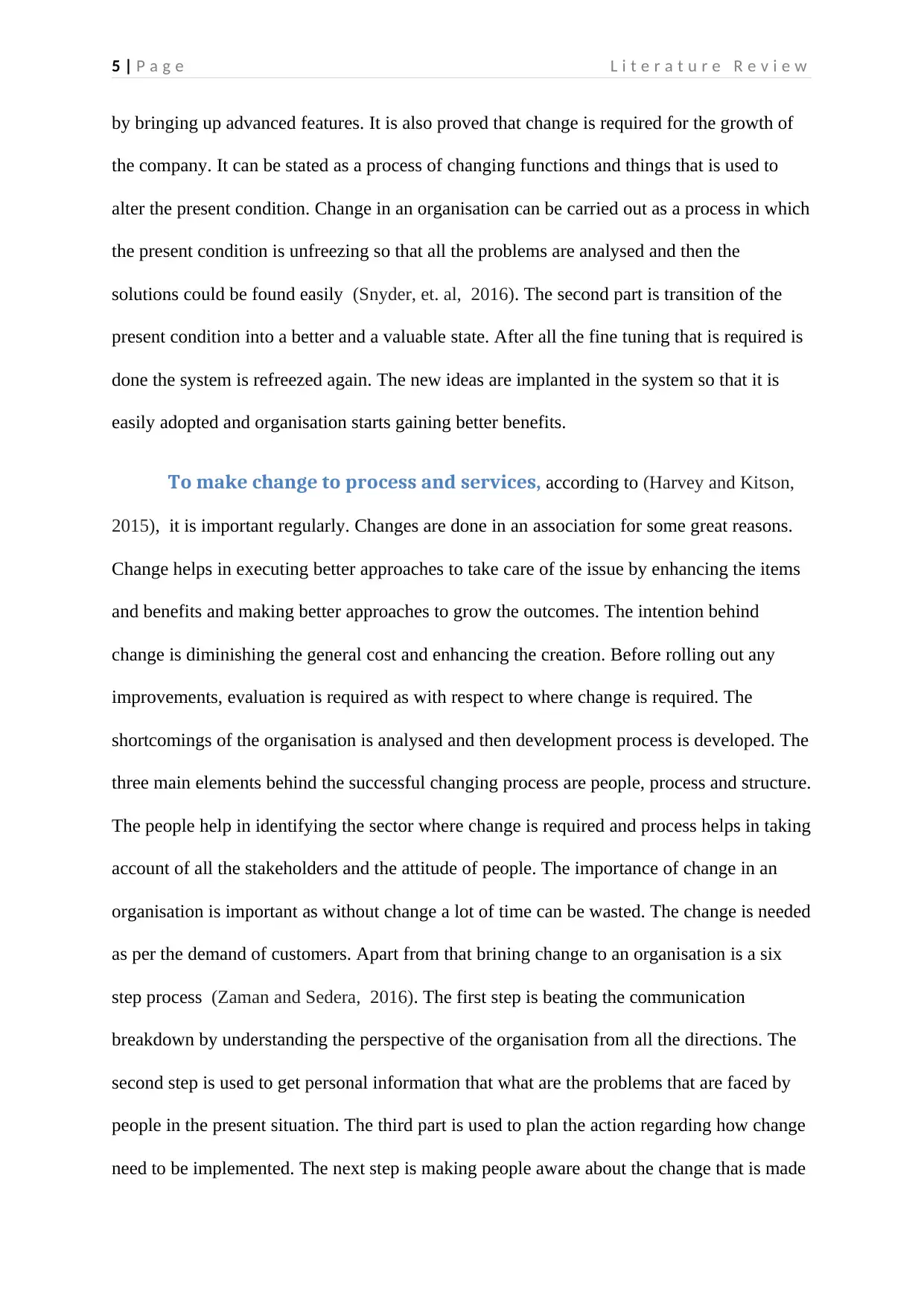
5 | P a g e L i t e r a t u r e R e v i e w
by bringing up advanced features. It is also proved that change is required for the growth of
the company. It can be stated as a process of changing functions and things that is used to
alter the present condition. Change in an organisation can be carried out as a process in which
the present condition is unfreezing so that all the problems are analysed and then the
solutions could be found easily (Snyder, et. al, 2016). The second part is transition of the
present condition into a better and a valuable state. After all the fine tuning that is required is
done the system is refreezed again. The new ideas are implanted in the system so that it is
easily adopted and organisation starts gaining better benefits.
To make change to process and services, according to (Harvey and Kitson,
2015), it is important regularly. Changes are done in an association for some great reasons.
Change helps in executing better approaches to take care of the issue by enhancing the items
and benefits and making better approaches to grow the outcomes. The intention behind
change is diminishing the general cost and enhancing the creation. Before rolling out any
improvements, evaluation is required as with respect to where change is required. The
shortcomings of the organisation is analysed and then development process is developed. The
three main elements behind the successful changing process are people, process and structure.
The people help in identifying the sector where change is required and process helps in taking
account of all the stakeholders and the attitude of people. The importance of change in an
organisation is important as without change a lot of time can be wasted. The change is needed
as per the demand of customers. Apart from that brining change to an organisation is a six
step process (Zaman and Sedera, 2016). The first step is beating the communication
breakdown by understanding the perspective of the organisation from all the directions. The
second step is used to get personal information that what are the problems that are faced by
people in the present situation. The third part is used to plan the action regarding how change
need to be implemented. The next step is making people aware about the change that is made
by bringing up advanced features. It is also proved that change is required for the growth of
the company. It can be stated as a process of changing functions and things that is used to
alter the present condition. Change in an organisation can be carried out as a process in which
the present condition is unfreezing so that all the problems are analysed and then the
solutions could be found easily (Snyder, et. al, 2016). The second part is transition of the
present condition into a better and a valuable state. After all the fine tuning that is required is
done the system is refreezed again. The new ideas are implanted in the system so that it is
easily adopted and organisation starts gaining better benefits.
To make change to process and services, according to (Harvey and Kitson,
2015), it is important regularly. Changes are done in an association for some great reasons.
Change helps in executing better approaches to take care of the issue by enhancing the items
and benefits and making better approaches to grow the outcomes. The intention behind
change is diminishing the general cost and enhancing the creation. Before rolling out any
improvements, evaluation is required as with respect to where change is required. The
shortcomings of the organisation is analysed and then development process is developed. The
three main elements behind the successful changing process are people, process and structure.
The people help in identifying the sector where change is required and process helps in taking
account of all the stakeholders and the attitude of people. The importance of change in an
organisation is important as without change a lot of time can be wasted. The change is needed
as per the demand of customers. Apart from that brining change to an organisation is a six
step process (Zaman and Sedera, 2016). The first step is beating the communication
breakdown by understanding the perspective of the organisation from all the directions. The
second step is used to get personal information that what are the problems that are faced by
people in the present situation. The third part is used to plan the action regarding how change
need to be implemented. The next step is making people aware about the change that is made
⊘ This is a preview!⊘
Do you want full access?
Subscribe today to unlock all pages.

Trusted by 1+ million students worldwide
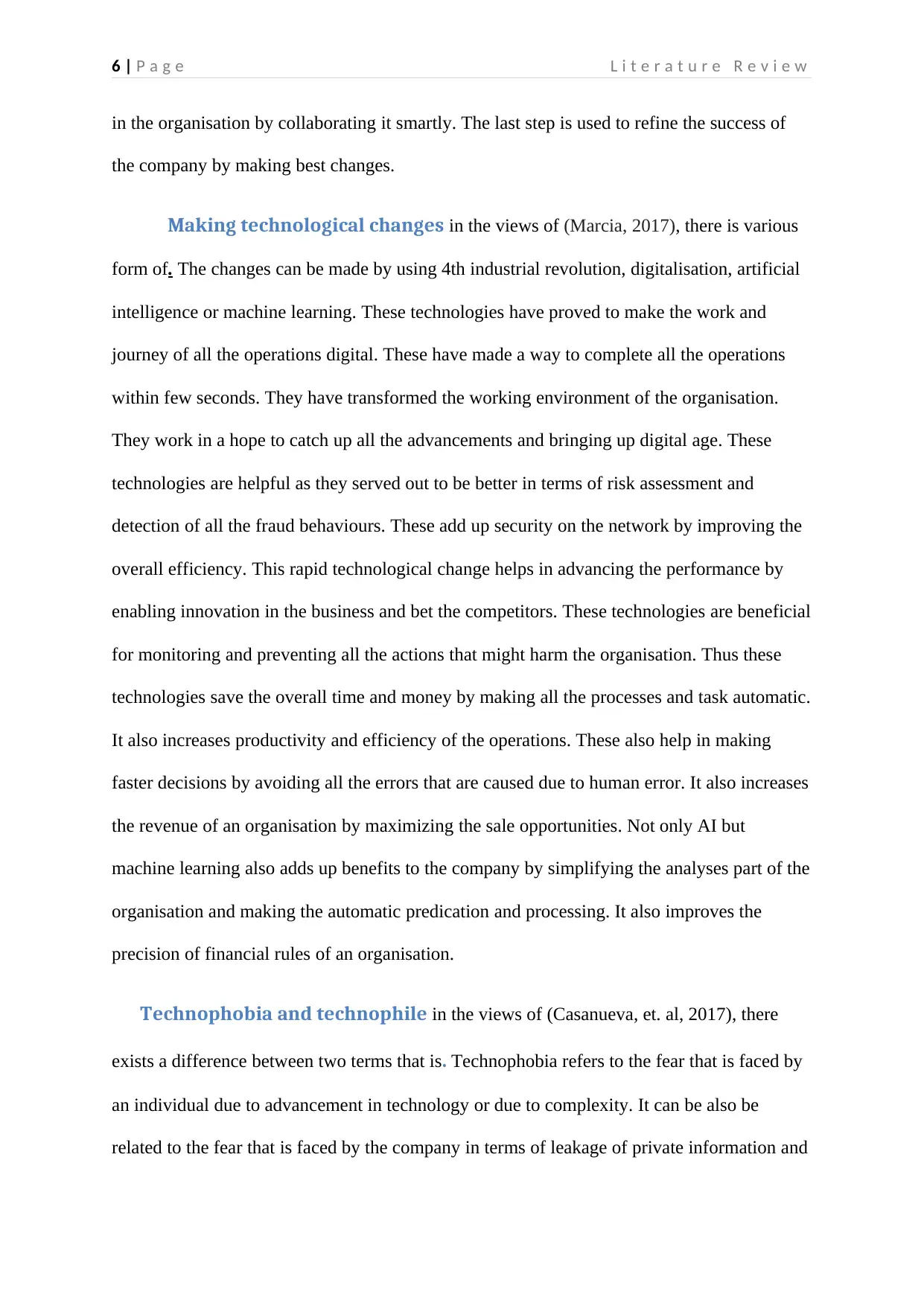
6 | P a g e L i t e r a t u r e R e v i e w
in the organisation by collaborating it smartly. The last step is used to refine the success of
the company by making best changes.
Making technological changes in the views of (Marcia, 2017), there is various
form of. The changes can be made by using 4th industrial revolution, digitalisation, artificial
intelligence or machine learning. These technologies have proved to make the work and
journey of all the operations digital. These have made a way to complete all the operations
within few seconds. They have transformed the working environment of the organisation.
They work in a hope to catch up all the advancements and bringing up digital age. These
technologies are helpful as they served out to be better in terms of risk assessment and
detection of all the fraud behaviours. These add up security on the network by improving the
overall efficiency. This rapid technological change helps in advancing the performance by
enabling innovation in the business and bet the competitors. These technologies are beneficial
for monitoring and preventing all the actions that might harm the organisation. Thus these
technologies save the overall time and money by making all the processes and task automatic.
It also increases productivity and efficiency of the operations. These also help in making
faster decisions by avoiding all the errors that are caused due to human error. It also increases
the revenue of an organisation by maximizing the sale opportunities. Not only AI but
machine learning also adds up benefits to the company by simplifying the analyses part of the
organisation and making the automatic predication and processing. It also improves the
precision of financial rules of an organisation.
Technophobia and technophile in the views of (Casanueva, et. al, 2017), there
exists a difference between two terms that is. Technophobia refers to the fear that is faced by
an individual due to advancement in technology or due to complexity. It can be also be
related to the fear that is faced by the company in terms of leakage of private information and
in the organisation by collaborating it smartly. The last step is used to refine the success of
the company by making best changes.
Making technological changes in the views of (Marcia, 2017), there is various
form of. The changes can be made by using 4th industrial revolution, digitalisation, artificial
intelligence or machine learning. These technologies have proved to make the work and
journey of all the operations digital. These have made a way to complete all the operations
within few seconds. They have transformed the working environment of the organisation.
They work in a hope to catch up all the advancements and bringing up digital age. These
technologies are helpful as they served out to be better in terms of risk assessment and
detection of all the fraud behaviours. These add up security on the network by improving the
overall efficiency. This rapid technological change helps in advancing the performance by
enabling innovation in the business and bet the competitors. These technologies are beneficial
for monitoring and preventing all the actions that might harm the organisation. Thus these
technologies save the overall time and money by making all the processes and task automatic.
It also increases productivity and efficiency of the operations. These also help in making
faster decisions by avoiding all the errors that are caused due to human error. It also increases
the revenue of an organisation by maximizing the sale opportunities. Not only AI but
machine learning also adds up benefits to the company by simplifying the analyses part of the
organisation and making the automatic predication and processing. It also improves the
precision of financial rules of an organisation.
Technophobia and technophile in the views of (Casanueva, et. al, 2017), there
exists a difference between two terms that is. Technophobia refers to the fear that is faced by
an individual due to advancement in technology or due to complexity. It can be also be
related to the fear that is faced by the company in terms of leakage of private information and
Paraphrase This Document
Need a fresh take? Get an instant paraphrase of this document with our AI Paraphraser
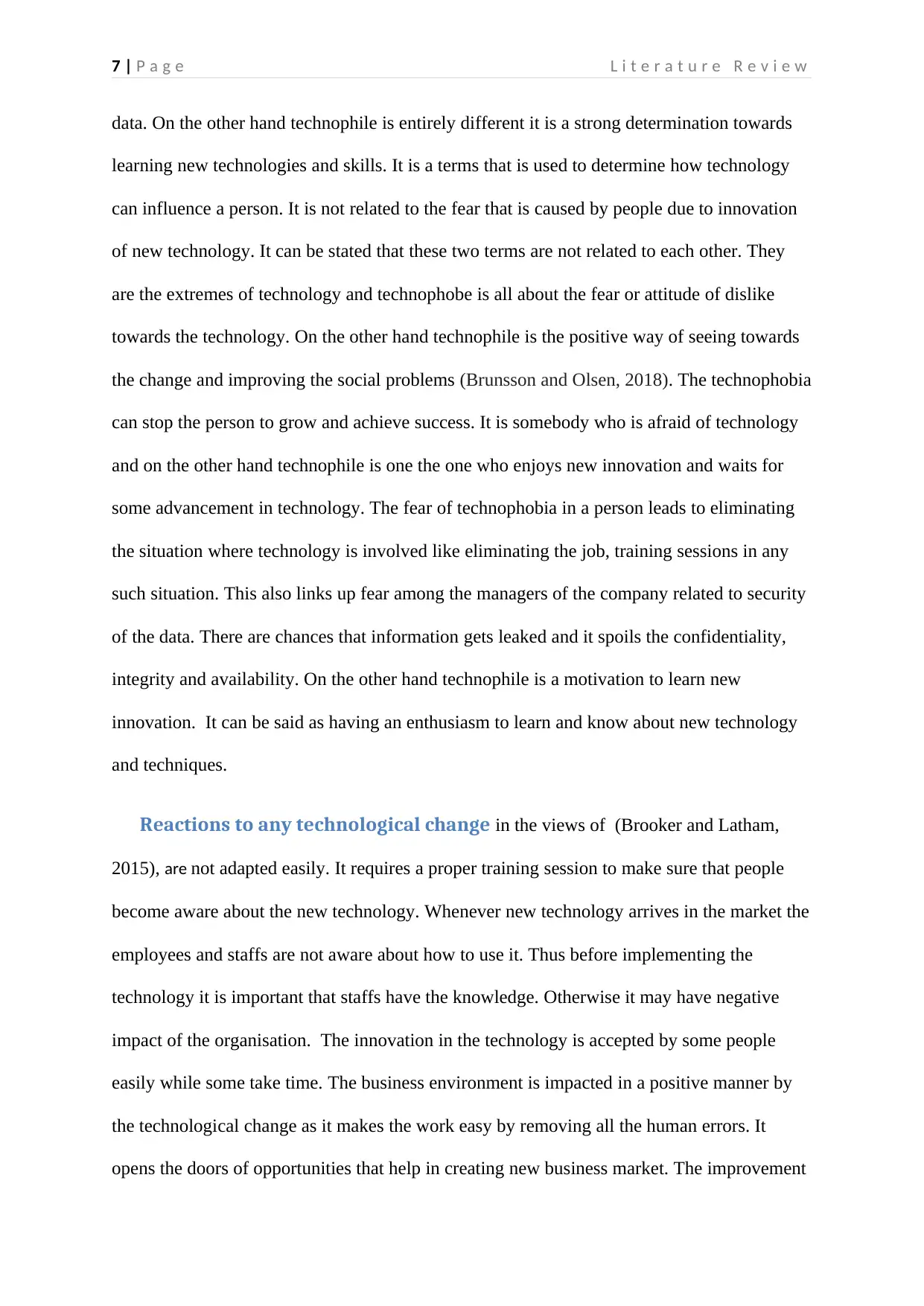
7 | P a g e L i t e r a t u r e R e v i e w
data. On the other hand technophile is entirely different it is a strong determination towards
learning new technologies and skills. It is a terms that is used to determine how technology
can influence a person. It is not related to the fear that is caused by people due to innovation
of new technology. It can be stated that these two terms are not related to each other. They
are the extremes of technology and technophobe is all about the fear or attitude of dislike
towards the technology. On the other hand technophile is the positive way of seeing towards
the change and improving the social problems (Brunsson and Olsen, 2018). The technophobia
can stop the person to grow and achieve success. It is somebody who is afraid of technology
and on the other hand technophile is one the one who enjoys new innovation and waits for
some advancement in technology. The fear of technophobia in a person leads to eliminating
the situation where technology is involved like eliminating the job, training sessions in any
such situation. This also links up fear among the managers of the company related to security
of the data. There are chances that information gets leaked and it spoils the confidentiality,
integrity and availability. On the other hand technophile is a motivation to learn new
innovation. It can be said as having an enthusiasm to learn and know about new technology
and techniques.
Reactions to any technological change in the views of (Brooker and Latham,
2015), are not adapted easily. It requires a proper training session to make sure that people
become aware about the new technology. Whenever new technology arrives in the market the
employees and staffs are not aware about how to use it. Thus before implementing the
technology it is important that staffs have the knowledge. Otherwise it may have negative
impact of the organisation. The innovation in the technology is accepted by some people
easily while some take time. The business environment is impacted in a positive manner by
the technological change as it makes the work easy by removing all the human errors. It
opens the doors of opportunities that help in creating new business market. The improvement
data. On the other hand technophile is entirely different it is a strong determination towards
learning new technologies and skills. It is a terms that is used to determine how technology
can influence a person. It is not related to the fear that is caused by people due to innovation
of new technology. It can be stated that these two terms are not related to each other. They
are the extremes of technology and technophobe is all about the fear or attitude of dislike
towards the technology. On the other hand technophile is the positive way of seeing towards
the change and improving the social problems (Brunsson and Olsen, 2018). The technophobia
can stop the person to grow and achieve success. It is somebody who is afraid of technology
and on the other hand technophile is one the one who enjoys new innovation and waits for
some advancement in technology. The fear of technophobia in a person leads to eliminating
the situation where technology is involved like eliminating the job, training sessions in any
such situation. This also links up fear among the managers of the company related to security
of the data. There are chances that information gets leaked and it spoils the confidentiality,
integrity and availability. On the other hand technophile is a motivation to learn new
innovation. It can be said as having an enthusiasm to learn and know about new technology
and techniques.
Reactions to any technological change in the views of (Brooker and Latham,
2015), are not adapted easily. It requires a proper training session to make sure that people
become aware about the new technology. Whenever new technology arrives in the market the
employees and staffs are not aware about how to use it. Thus before implementing the
technology it is important that staffs have the knowledge. Otherwise it may have negative
impact of the organisation. The innovation in the technology is accepted by some people
easily while some take time. The business environment is impacted in a positive manner by
the technological change as it makes the work easy by removing all the human errors. It
opens the doors of opportunities that help in creating new business market. The improvement
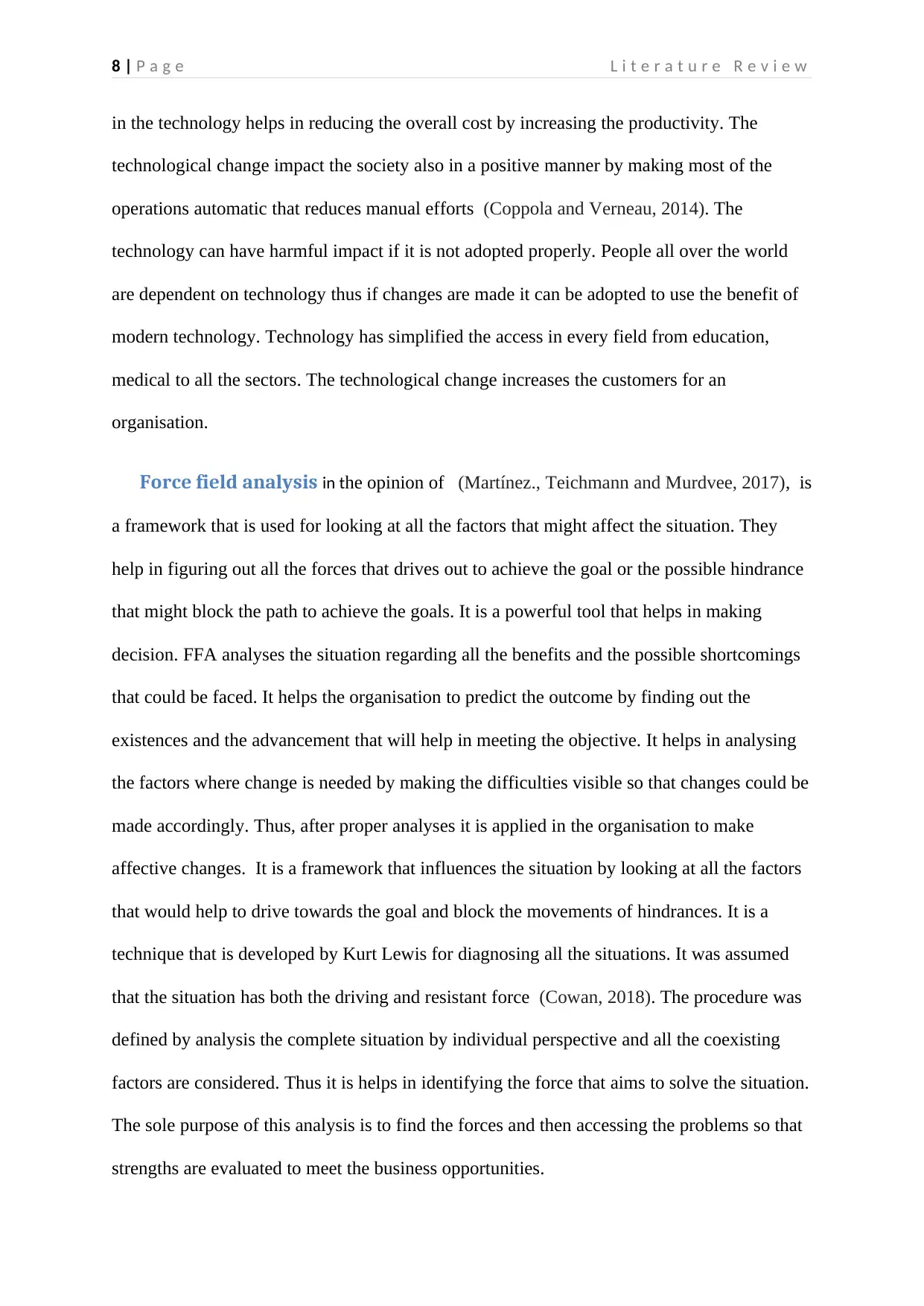
8 | P a g e L i t e r a t u r e R e v i e w
in the technology helps in reducing the overall cost by increasing the productivity. The
technological change impact the society also in a positive manner by making most of the
operations automatic that reduces manual efforts (Coppola and Verneau, 2014). The
technology can have harmful impact if it is not adopted properly. People all over the world
are dependent on technology thus if changes are made it can be adopted to use the benefit of
modern technology. Technology has simplified the access in every field from education,
medical to all the sectors. The technological change increases the customers for an
organisation.
Force field analysis in the opinion of (Martínez., Teichmann and Murdvee, 2017), is
a framework that is used for looking at all the factors that might affect the situation. They
help in figuring out all the forces that drives out to achieve the goal or the possible hindrance
that might block the path to achieve the goals. It is a powerful tool that helps in making
decision. FFA analyses the situation regarding all the benefits and the possible shortcomings
that could be faced. It helps the organisation to predict the outcome by finding out the
existences and the advancement that will help in meeting the objective. It helps in analysing
the factors where change is needed by making the difficulties visible so that changes could be
made accordingly. Thus, after proper analyses it is applied in the organisation to make
affective changes. It is a framework that influences the situation by looking at all the factors
that would help to drive towards the goal and block the movements of hindrances. It is a
technique that is developed by Kurt Lewis for diagnosing all the situations. It was assumed
that the situation has both the driving and resistant force (Cowan, 2018). The procedure was
defined by analysis the complete situation by individual perspective and all the coexisting
factors are considered. Thus it is helps in identifying the force that aims to solve the situation.
The sole purpose of this analysis is to find the forces and then accessing the problems so that
strengths are evaluated to meet the business opportunities.
in the technology helps in reducing the overall cost by increasing the productivity. The
technological change impact the society also in a positive manner by making most of the
operations automatic that reduces manual efforts (Coppola and Verneau, 2014). The
technology can have harmful impact if it is not adopted properly. People all over the world
are dependent on technology thus if changes are made it can be adopted to use the benefit of
modern technology. Technology has simplified the access in every field from education,
medical to all the sectors. The technological change increases the customers for an
organisation.
Force field analysis in the opinion of (Martínez., Teichmann and Murdvee, 2017), is
a framework that is used for looking at all the factors that might affect the situation. They
help in figuring out all the forces that drives out to achieve the goal or the possible hindrance
that might block the path to achieve the goals. It is a powerful tool that helps in making
decision. FFA analyses the situation regarding all the benefits and the possible shortcomings
that could be faced. It helps the organisation to predict the outcome by finding out the
existences and the advancement that will help in meeting the objective. It helps in analysing
the factors where change is needed by making the difficulties visible so that changes could be
made accordingly. Thus, after proper analyses it is applied in the organisation to make
affective changes. It is a framework that influences the situation by looking at all the factors
that would help to drive towards the goal and block the movements of hindrances. It is a
technique that is developed by Kurt Lewis for diagnosing all the situations. It was assumed
that the situation has both the driving and resistant force (Cowan, 2018). The procedure was
defined by analysis the complete situation by individual perspective and all the coexisting
factors are considered. Thus it is helps in identifying the force that aims to solve the situation.
The sole purpose of this analysis is to find the forces and then accessing the problems so that
strengths are evaluated to meet the business opportunities.
⊘ This is a preview!⊘
Do you want full access?
Subscribe today to unlock all pages.

Trusted by 1+ million students worldwide
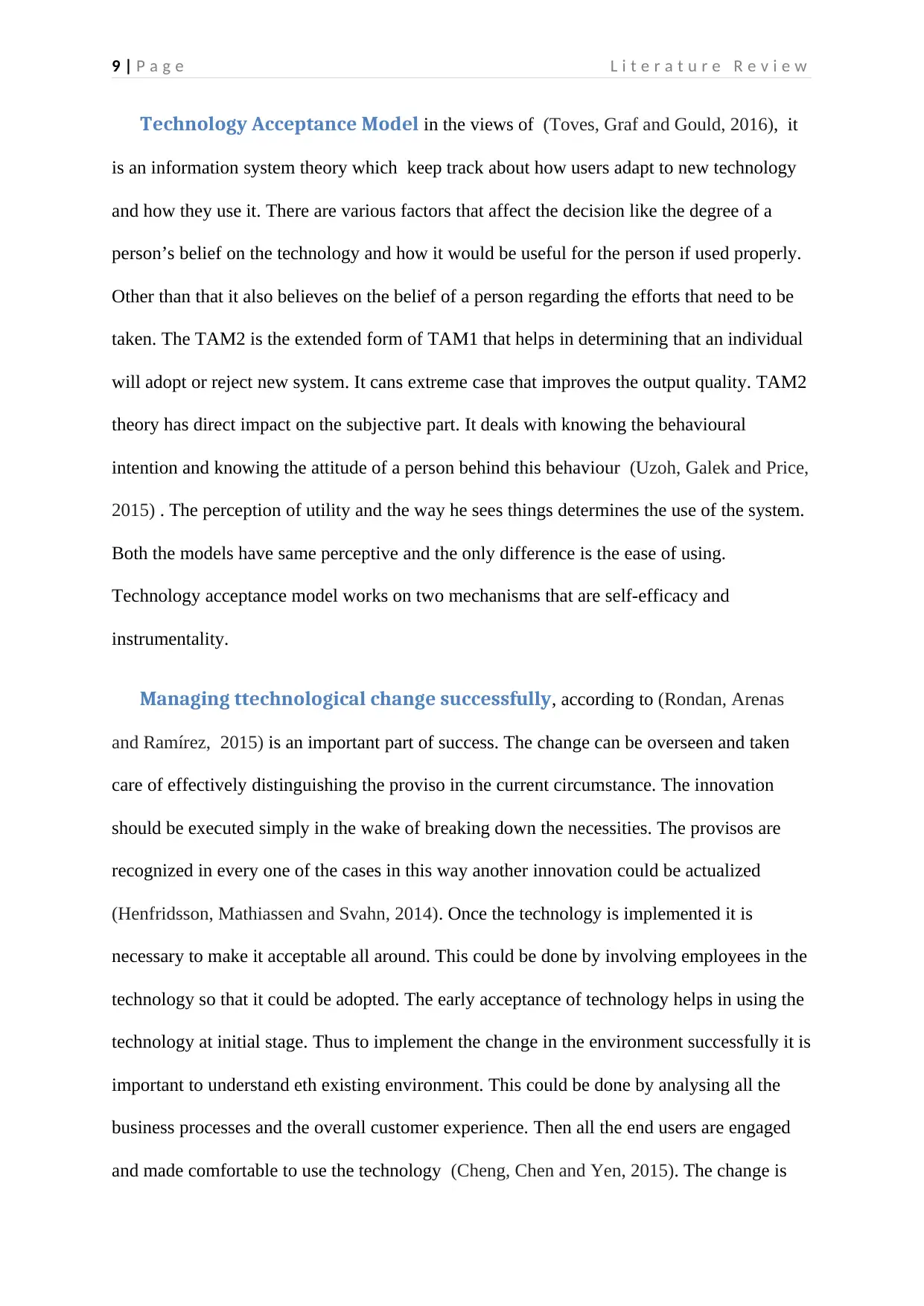
9 | P a g e L i t e r a t u r e R e v i e w
Technology Acceptance Model in the views of (Toves, Graf and Gould, 2016), it
is an information system theory which keep track about how users adapt to new technology
and how they use it. There are various factors that affect the decision like the degree of a
person’s belief on the technology and how it would be useful for the person if used properly.
Other than that it also believes on the belief of a person regarding the efforts that need to be
taken. The TAM2 is the extended form of TAM1 that helps in determining that an individual
will adopt or reject new system. It cans extreme case that improves the output quality. TAM2
theory has direct impact on the subjective part. It deals with knowing the behavioural
intention and knowing the attitude of a person behind this behaviour (Uzoh, Galek and Price,
2015) . The perception of utility and the way he sees things determines the use of the system.
Both the models have same perceptive and the only difference is the ease of using.
Technology acceptance model works on two mechanisms that are self-efficacy and
instrumentality.
Managing ttechnological change successfully, according to (Rondan, Arenas
and Ramírez, 2015) is an important part of success. The change can be overseen and taken
care of effectively distinguishing the proviso in the current circumstance. The innovation
should be executed simply in the wake of breaking down the necessities. The provisos are
recognized in every one of the cases in this way another innovation could be actualized
(Henfridsson, Mathiassen and Svahn, 2014). Once the technology is implemented it is
necessary to make it acceptable all around. This could be done by involving employees in the
technology so that it could be adopted. The early acceptance of technology helps in using the
technology at initial stage. Thus to implement the change in the environment successfully it is
important to understand eth existing environment. This could be done by analysing all the
business processes and the overall customer experience. Then all the end users are engaged
and made comfortable to use the technology (Cheng, Chen and Yen, 2015). The change is
Technology Acceptance Model in the views of (Toves, Graf and Gould, 2016), it
is an information system theory which keep track about how users adapt to new technology
and how they use it. There are various factors that affect the decision like the degree of a
person’s belief on the technology and how it would be useful for the person if used properly.
Other than that it also believes on the belief of a person regarding the efforts that need to be
taken. The TAM2 is the extended form of TAM1 that helps in determining that an individual
will adopt or reject new system. It cans extreme case that improves the output quality. TAM2
theory has direct impact on the subjective part. It deals with knowing the behavioural
intention and knowing the attitude of a person behind this behaviour (Uzoh, Galek and Price,
2015) . The perception of utility and the way he sees things determines the use of the system.
Both the models have same perceptive and the only difference is the ease of using.
Technology acceptance model works on two mechanisms that are self-efficacy and
instrumentality.
Managing ttechnological change successfully, according to (Rondan, Arenas
and Ramírez, 2015) is an important part of success. The change can be overseen and taken
care of effectively distinguishing the proviso in the current circumstance. The innovation
should be executed simply in the wake of breaking down the necessities. The provisos are
recognized in every one of the cases in this way another innovation could be actualized
(Henfridsson, Mathiassen and Svahn, 2014). Once the technology is implemented it is
necessary to make it acceptable all around. This could be done by involving employees in the
technology so that it could be adopted. The early acceptance of technology helps in using the
technology at initial stage. Thus to implement the change in the environment successfully it is
important to understand eth existing environment. This could be done by analysing all the
business processes and the overall customer experience. Then all the end users are engaged
and made comfortable to use the technology (Cheng, Chen and Yen, 2015). The change is
Paraphrase This Document
Need a fresh take? Get an instant paraphrase of this document with our AI Paraphraser
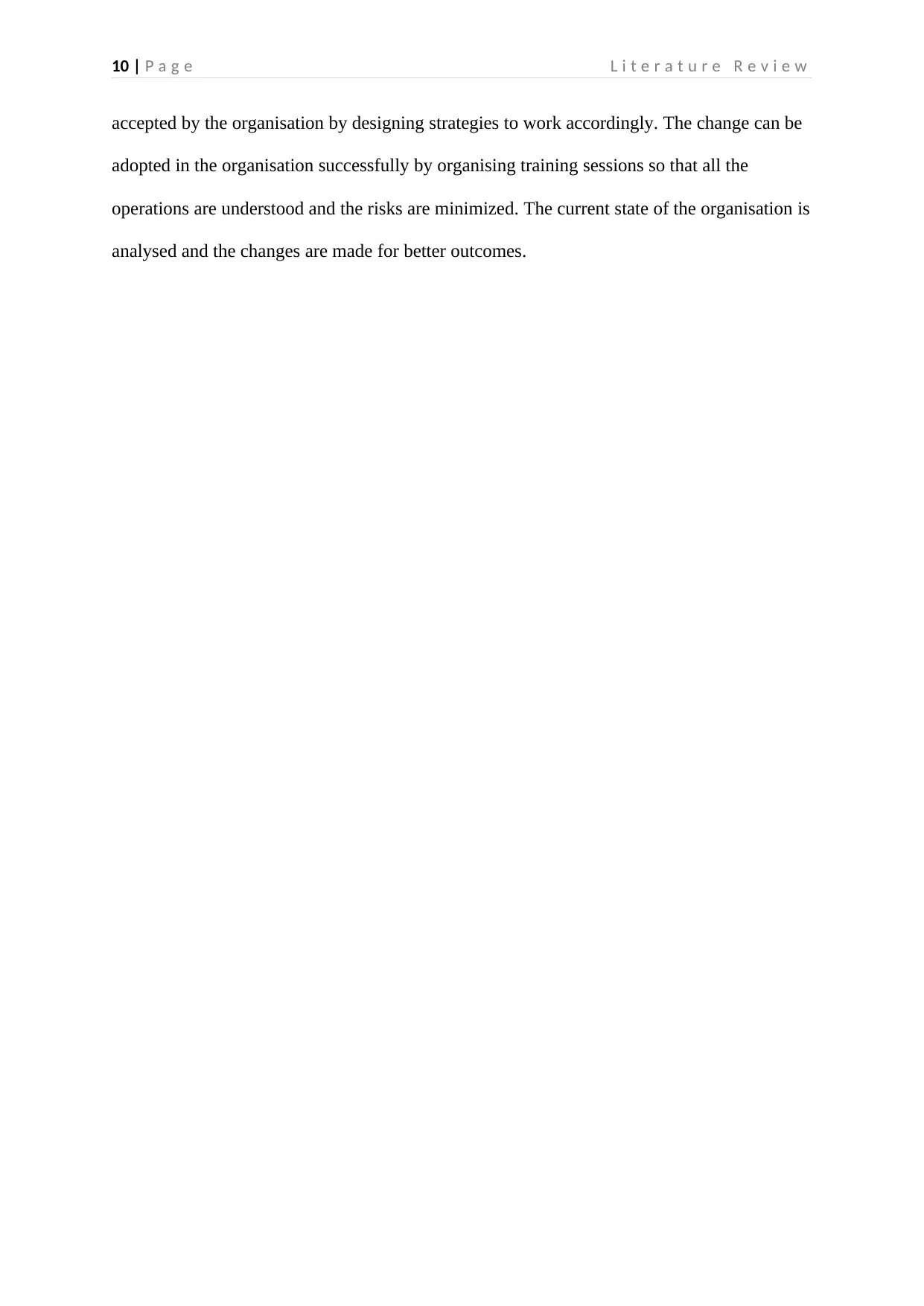
10 | P a g e L i t e r a t u r e R e v i e w
accepted by the organisation by designing strategies to work accordingly. The change can be
adopted in the organisation successfully by organising training sessions so that all the
operations are understood and the risks are minimized. The current state of the organisation is
analysed and the changes are made for better outcomes.
accepted by the organisation by designing strategies to work accordingly. The change can be
adopted in the organisation successfully by organising training sessions so that all the
operations are understood and the risks are minimized. The current state of the organisation is
analysed and the changes are made for better outcomes.
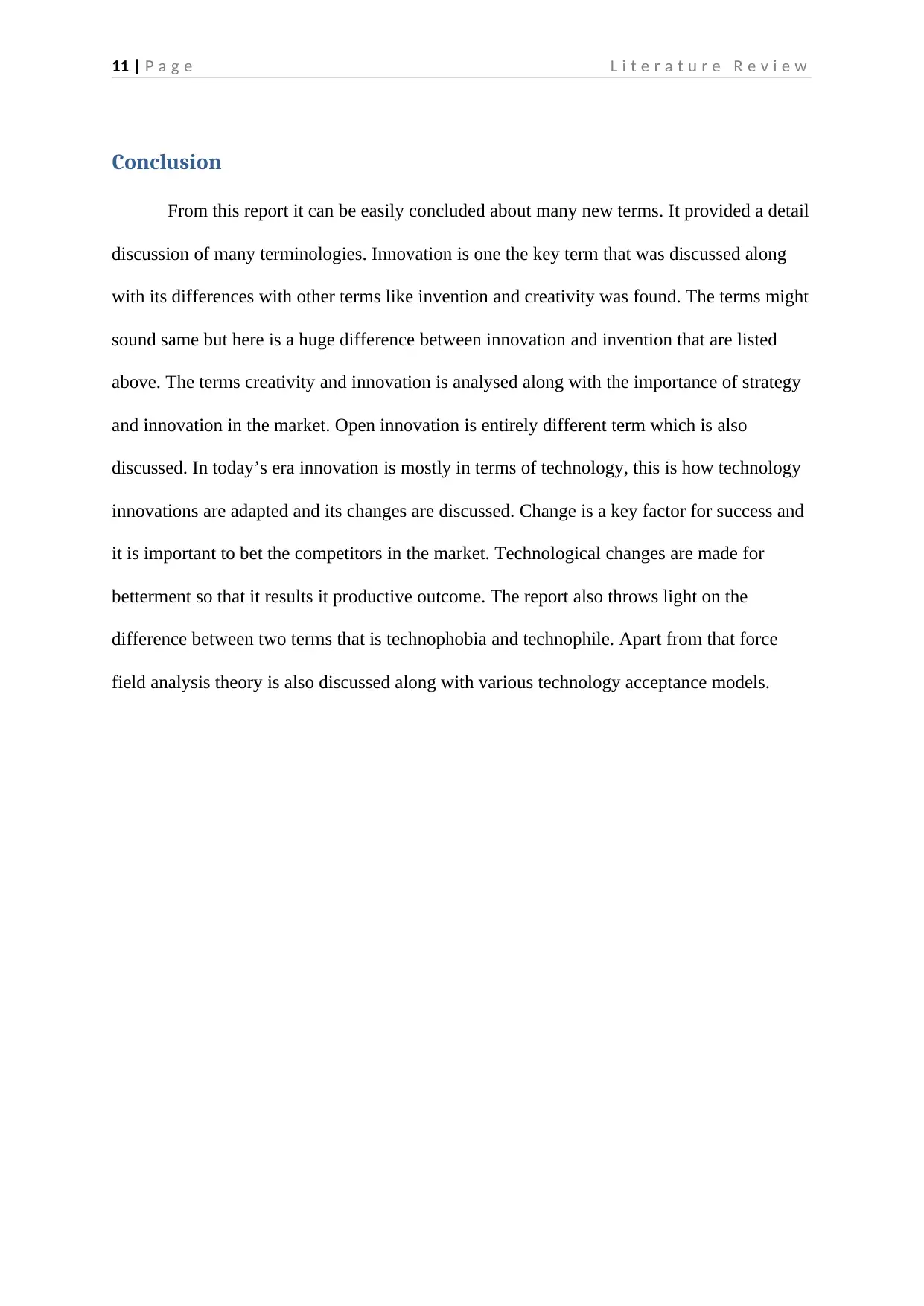
11 | P a g e L i t e r a t u r e R e v i e w
Conclusion
From this report it can be easily concluded about many new terms. It provided a detail
discussion of many terminologies. Innovation is one the key term that was discussed along
with its differences with other terms like invention and creativity was found. The terms might
sound same but here is a huge difference between innovation and invention that are listed
above. The terms creativity and innovation is analysed along with the importance of strategy
and innovation in the market. Open innovation is entirely different term which is also
discussed. In today’s era innovation is mostly in terms of technology, this is how technology
innovations are adapted and its changes are discussed. Change is a key factor for success and
it is important to bet the competitors in the market. Technological changes are made for
betterment so that it results it productive outcome. The report also throws light on the
difference between two terms that is technophobia and technophile. Apart from that force
field analysis theory is also discussed along with various technology acceptance models.
Conclusion
From this report it can be easily concluded about many new terms. It provided a detail
discussion of many terminologies. Innovation is one the key term that was discussed along
with its differences with other terms like invention and creativity was found. The terms might
sound same but here is a huge difference between innovation and invention that are listed
above. The terms creativity and innovation is analysed along with the importance of strategy
and innovation in the market. Open innovation is entirely different term which is also
discussed. In today’s era innovation is mostly in terms of technology, this is how technology
innovations are adapted and its changes are discussed. Change is a key factor for success and
it is important to bet the competitors in the market. Technological changes are made for
betterment so that it results it productive outcome. The report also throws light on the
difference between two terms that is technophobia and technophile. Apart from that force
field analysis theory is also discussed along with various technology acceptance models.
⊘ This is a preview!⊘
Do you want full access?
Subscribe today to unlock all pages.

Trusted by 1+ million students worldwide
1 out of 16
Related Documents
Your All-in-One AI-Powered Toolkit for Academic Success.
+13062052269
info@desklib.com
Available 24*7 on WhatsApp / Email
![[object Object]](/_next/static/media/star-bottom.7253800d.svg)
Unlock your academic potential
Copyright © 2020–2025 A2Z Services. All Rights Reserved. Developed and managed by ZUCOL.





